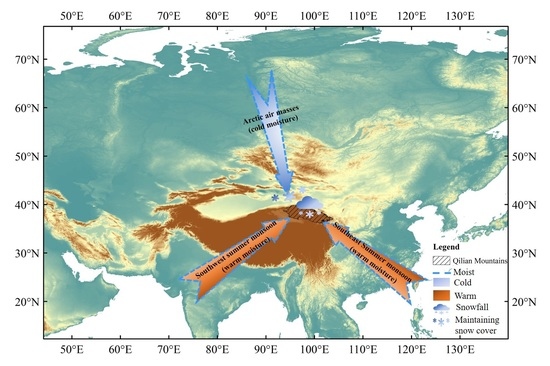Spatiotemporal Variation of Snow Cover Frequency in the Qilian Mountains (Northwestern China) during 2000–2020 and Associated Circulation Mechanisms
Abstract
:1. Introduction
2. Description of Study Region
3. Data Resources and Methodology
3.1. Data Resources
3.1.1. Remote Sensing Imagery
3.1.2. Digital Elevation Model
3.1.3. Meteorological Data
3.1.4. Reanalysis Data
3.2. Methodology
4. Results and Discussion
4.1. Spatiotemporal Pattern of SCF
4.2. Abrupt Change, Oscillations, and Atmospheric Circulations Associated with SCF
4.3. Influence of Topography on SCF
4.4. Influence of Air Temperature and Precipitation on SCF
4.5. Atmospheric Circulation Mechanisms of Years with High/Low SCFs
5. Conclusions
Author Contributions
Funding
Data Availability Statement
Conflicts of Interest
References
- Liston, G.E. Interrelationships among snow distribution, snowmelt, and snow cover depletion: Implications for atmospheric, hydrologic, and ecologic modeling. J. Appl. Meteorol. Climatol. 1999, 38, 1474–1487. [Google Scholar] [CrossRef]
- Ye, T.; Liu, W.; Mu, Q.; Zong, S.; Li, Y.; Shi, P. Quantifying livestock vulnerability to snow disasters in the Tibetan Plateau: Comparing different modeling techniques for prediction. Int. J. Disaster Risk Reduct. 2020, 48, 101578. [Google Scholar] [CrossRef]
- Wu, X.; Wang, X.; Liu, S.; Yang, Y.; Xu, G.; Xu, Y.; Jiang, T.; Xiao, C. Snow cover loss compounding the future economic vulnerability of western China. Sci. Total Environ. 2021, 755, 143025. [Google Scholar] [CrossRef] [PubMed]
- Qin, D.; Yao, T.; Ding, Y.; Ren, J. An Introduction to Cryosphere Science; China Science Publishing & Media Ltd.: Beijing, China, 2017; pp. 13–26. (In Chinese) [Google Scholar]
- Li, W.; Qiu, B.; Guo, W.; Zhu, Z.; Hsu, P. Intraseasonal variability of Tibetan Plateau snow cover. Int. J. Climatol. 2020, 40, 3451–3466. [Google Scholar] [CrossRef] [Green Version]
- You, Q.; Wu, T.; Shen, L.; Pepin, N.; Zhang, L.; Jiang, Z.; Wu, Z.; Kang, S.; AghaKouchak., A. Review of snow cover variation over the Tibetan Plateau and its influence on the broad climate system. Earth-Sci. Rev. 2020, 201, 103043. [Google Scholar] [CrossRef]
- Zhang, T.; Wang, T.; Zhao, Y.; Xu, C.; Feng, Y.; Liu, D. Drivers of Eurasian Spring Snow-Cover Variability. J. Clim. 2021, 34, 2037–2052. [Google Scholar] [CrossRef]
- Handorf, D.; Jaiser, R.; Dethloff, K.; Rinke, A.; Cohen, J. Impacts of Arctic sea ice and continental snow cover changes on atmospheric winter teleconnections. Geophys. Res. Lett. 2015, 42, 2367–2377. [Google Scholar] [CrossRef] [Green Version]
- Huang, X.; Deng, J.; Ma, X.; Wang, Y.; Feng, Q.; Hao, X.; Liang, T. Spatiotemporal dynamics of snow cover based on multi-source remote sensing data in China. Cryosphere 2016, 10, 2453–2463. [Google Scholar] [CrossRef] [Green Version]
- Ke, C.Q.; Li, X.C.; Xie, H.; Ma, D.H.; Liu, X.; Kou, C. Variability in snow cover phenology in China from 1952 to 2010. Hydrol. Earth Syst. Sci. 2016, 20, 755–770. [Google Scholar] [CrossRef] [Green Version]
- Jiang, Y.; Chen, F.; Gao, Y.; He, C.; Barlage, M.; Huang, W. Assessment of uncertainty sources in snow cover simulation in the Tibetan Plateau. J. Geophys. Res. Atmos. 2020, 125, e2020JD032674. [Google Scholar] [CrossRef]
- Zhang, H.; Zhang, F.; Che, T.; Wang, S. Comparative evaluation of VIIRS daily snow cover product with MODIS for snow detection in China based on ground observations. Sci. Total Environ. 2020, 724, 138156. [Google Scholar] [CrossRef] [PubMed]
- Wang, X.; Xie, H.; Liang, T.; Huang, X. Comparison and validation of MODIS standard and new combination of Terra and Aqua snow cover products in northern Xinjiang, China. Hydrol. Process. Int. J. 2009, 23, 419–429. [Google Scholar] [CrossRef]
- Hall, D.K.; Riggs, G.A. Accuracy assessment of the MODIS snow products. Hydrol. Process. Int. J. 2007, 21, 1534–1547. [Google Scholar] [CrossRef]
- Aghelpour, P.; Guan, Y.; Bahrami-Pichaghchi, H.; Mohammadi, B.; Kisi, O.; Zhang, D. Using the MODIS sensor for snow cover modeling and the assessment of drought effects on snow cover in a mountainous area. Remote Sens. 2020, 12, 3437. [Google Scholar] [CrossRef]
- Wang, X.; Wu, C.; Wang, H.; Gonsamo, A.; Liu, Z. No evidence of widespread decline of snow cover on the Tibetan Plateau over 2000–2015. Sci. Rep. 2017, 7, 14645. [Google Scholar] [CrossRef]
- Ma, A.; Zhao, J.; Cai, L.; Dong, Z.; Yang, R. Potential links between wintertime snow cover in central Europe and precipitation over the low—Latitude highlands of China in May. Atmos. Sci. Lett. 2021, 22, e1063. [Google Scholar] [CrossRef]
- Brown, R.D.; Mote, P.W. The response of Northern Hemisphere snow cover to a changing climate. J. Clim. 2009, 22, 2124–2145. [Google Scholar] [CrossRef]
- Xuejin, T.; Zhenni, W.; Xingmin, M.; Peng, G.; Guangju, Z.; Wenyi, S.; Chaojun, G. Spatiotemporal changes in snow cover over China during 1960–2013. Atmos. Res. 2019, 218, 183–194. [Google Scholar] [CrossRef]
- Ding, R.; Li, J.; Wang, S.; Ren, F. Decadal change of the spring dust storm in northwest China and the associated atmospheric circulation. Geophys. Res. Lett. 2005, 32, L02808. [Google Scholar] [CrossRef] [Green Version]
- Liu, Q. Spatiotemporal Snow Pattern in the Qilian Mountains from 2001 to 2018. Master’s Dissertation, Delft University of Technology, Delft, The Netherlands, 2020; pp. 1–63. [Google Scholar]
- Bourque, C.; Mir, M. Seasonal snow cover in the Qilian Mountains of Northwest China: Its dependence on oasis seasonal evolution and lowland production of water vapour. J. Hydrol. 2012, 454, 141–151. [Google Scholar] [CrossRef]
- Sun, M.; Liu, S.; Yao, X.; Guo, W.; Xu, J. Glacier changes in the Qilian Mountains in the past half-century: Based on the revised First and Second Chinese Glacier Inventory. J. Geogr. Sci. 2018, 28, 206–220. [Google Scholar] [CrossRef] [Green Version]
- Zhao, Q.; Ye, B.; Ding, Y.; Zhang, S.; Yi, S.; Wang, J.; Shangguan, D.; Zhao, C.; Han, H. Coupling a glacier melt model to the Variable Infiltration Capacity (VIC) model for hydrological modeling in north-western China. Environ. Earth Sci. 2013, 68, 87–101. [Google Scholar] [CrossRef]
- Zhou, X.; Xie, H.; Hendrickx, J. Statistical evaluation of remotely sensed snow-cover products with constraints from streamflow and SNOTEL measurements. Remote Sens. Environ. 2005, 94, 214–231. [Google Scholar] [CrossRef]
- Tahir, A.; Chevallier, P.; Arnaud, Y.; Ahmad, B. Snow cover dynamics and hydrological regime of the Hunza River basin, Karakoram Range, Northern Pakistan. Hydrol. Earth Syst. Sci. 2011, 15, 2275–2290. [Google Scholar] [CrossRef] [Green Version]
- Feng, S.; Hu, Q.; Qian, W. Quality control of daily meteorological data in China, 1951–2000: A new dataset. Int. J. Climatol. 2004, 24, 853–870. [Google Scholar] [CrossRef]
- Zahumenský, I. Guidelines on quality control procedures for data from automatic weather stations. World Meteorol. Organ. Switz. 2004, 955, 1–20. [Google Scholar]
- Hersbach, H.; Bell, B.; Berrisford, P.; Hirahara, S.; Horányi, A.; Muñoz-Sabater, J.; Nicolas, J.; Peubey, C.; Radu, R.; Schepers, D.; et al. The ERA5 global reanalysis. Q. J. R. Meteorol. Soc. 2020, 146, 1999–2049. [Google Scholar] [CrossRef]
- Stow, D.; Daeschner, S.; Hope, A.; Douglas, D.; Petersen, A.; Myneni, R.; Zhou, L.; Oechel, W. Variability of the seasonally integrated normalized difference vegetation index across the north slope of Alaska in the 1990s. Int. J. Remote Sens. 2003, 24, 1111–1117. [Google Scholar] [CrossRef]
- Li, Y.; Pan, X.; Wang, C.; Liu, Y.; Zhao, Q. Changes of vegetation net primary productivity and its driving factors from 2000 to 2011 in Guangxi, China. Acta Ecol. Sin. 2014, 34, 5220–5228. (In Chinese) [Google Scholar]
- Jiang, Y.; Du, W.; Chen, J.; Sun, W. Spatiotemporal Variations in Snow Cover and Hydrological Effects in the Upstream Region of the Shule River Catchment, Northwestern China. Remote Sens. 2021, 13, 3212. [Google Scholar] [CrossRef]
- Ma, N.; Yu, K.; Zhang, Y.; Zhai, J.; Zhang, Y.; Zhang, H. Ground observed climatology and trend in snow cover phenology across China with consideration of snow-free breaks. Clim. Dyn. 2020, 55, 2867–2887. [Google Scholar] [CrossRef]
- Jiang, Y.; Du, W.; Chen, J.; Wang, C.; Wang, J.; Sun, W.; Chai, X.; Ma, L.; Xu, Z. Climatic and Topographical Effects on the Spatiotemporal Variations of Vegetation in Hexi Corridor, Northwestern China. Diversity 2022, 14, 370. [Google Scholar] [CrossRef]
- Wang, C.; Deser, C.; Yu, J.; DiNezio, P.; Clement, A. El Niño and southern oscillation (ENSO): A review. In Coral Reefs of the Eastern Tropical Pacific; Springer: Dordrecht, The Netherlands, 2017; pp. 85–106. [Google Scholar]
- Wang, L.; Wang, W.; Du, H.; Wu, Z.; Shen, X.; Ma, S. Decreasing precipitation occurs in daily extreme precipitation intervals across China in observations and model simulations. Clim. Dyn. 2020, 54, 2597–2612. [Google Scholar] [CrossRef]
- Cheng, P.; Luo, H.; Liu, Q.; Li, B.; Cao, Y.; Shang, Z. Characters of precipitable water vapor in Qilian Mountains based on ground-based GPS data. Meteor Mon 2021, 47, 1135–1145. (In Chinese) [Google Scholar]
- Zhao, C.; Ding, Y.; Yao, S. The variation of precipitation and rain days for different intensity classes during the rainy season in the Qilian Mountains, Northwest China. Theor. Appl. Climatol. 2021, 144, 163–178. [Google Scholar] [CrossRef]
- Wilks, D. “The stippling shows statistically significant grid points”: How research results are routinely overstated, over interpreted, and what to do about it. Bull. Am. Met. Soc. 2016, 97, 2263–2273. [Google Scholar] [CrossRef]
- Qin, D.; Liu, S.; Li, P. Snow cover distribution, variability, and response to climate change in western China. J. Clim. 2006, 19, 1820–1833. [Google Scholar]
- Seager, R.; Kushnir, Y.; Nakamura, J.; Ting, M.; Naik, N. Northern Hemisphere winter snow anomalies: ENSO, NAO and the winter of 2009/10. Geophys. Res. Lett. 2010, 37, L14703. [Google Scholar] [CrossRef] [Green Version]
- Cheung, H.; Zhou, W.; Mok, H.; Wu, M. Relationship between Ural–Siberian blocking and the East Asian winter monsoon in relation to the Arctic Oscillation and the El Niño–Southern Oscillation. J. Clim. 2012, 25, 4242–4257. [Google Scholar] [CrossRef]
- Pithan, F.; Svensson, G.; Caballero, R.; Chechin, D.; Cronin, T.; Ekman, A.; Neggers, R.; Shupe, M.; Solomon, A.; Tjernström, M.; et al. Role of air-mass transformations in exchange between the Arctic and mid-latitudes. Nat. Geosci. 2018, 11, 805–812. [Google Scholar] [CrossRef]
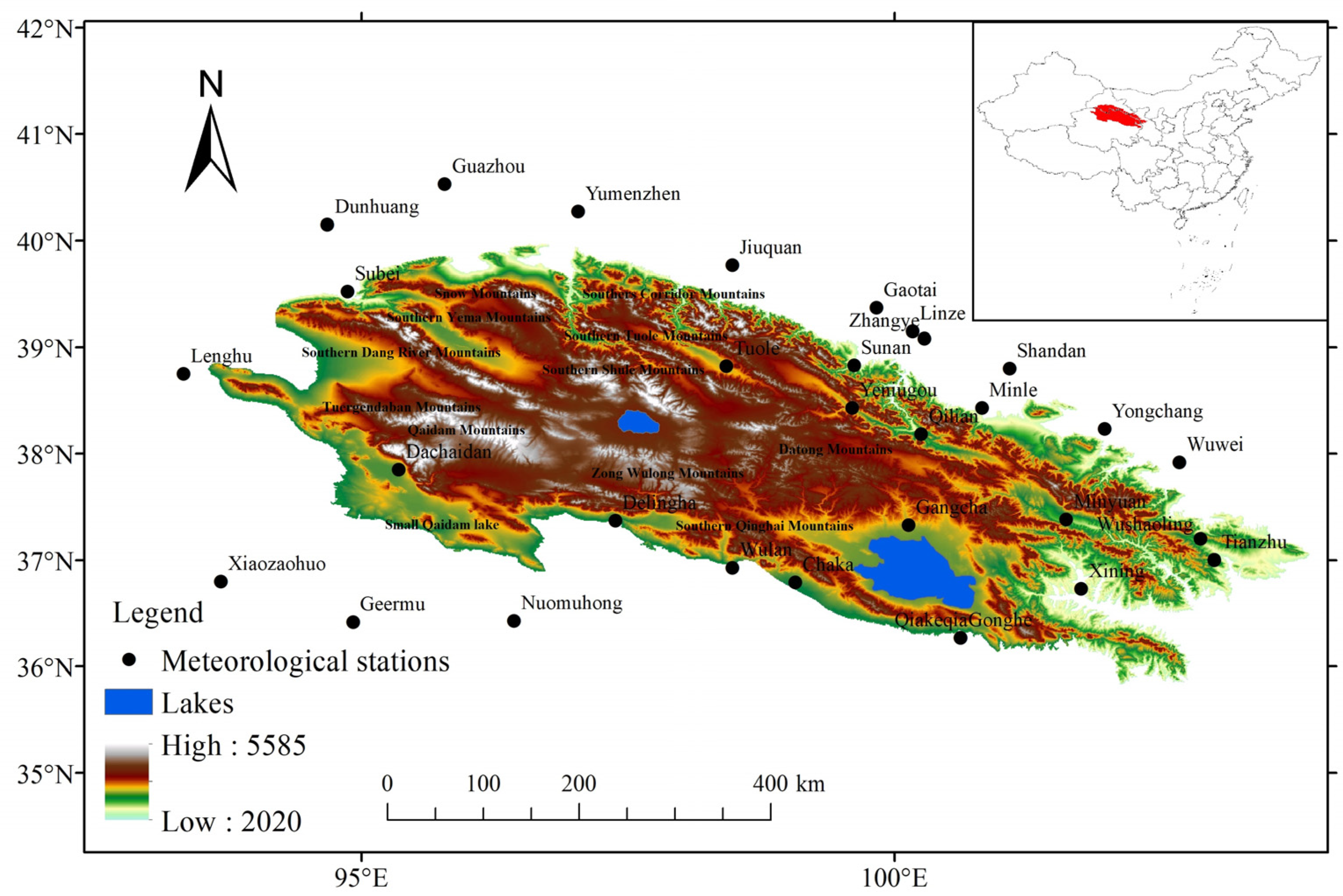
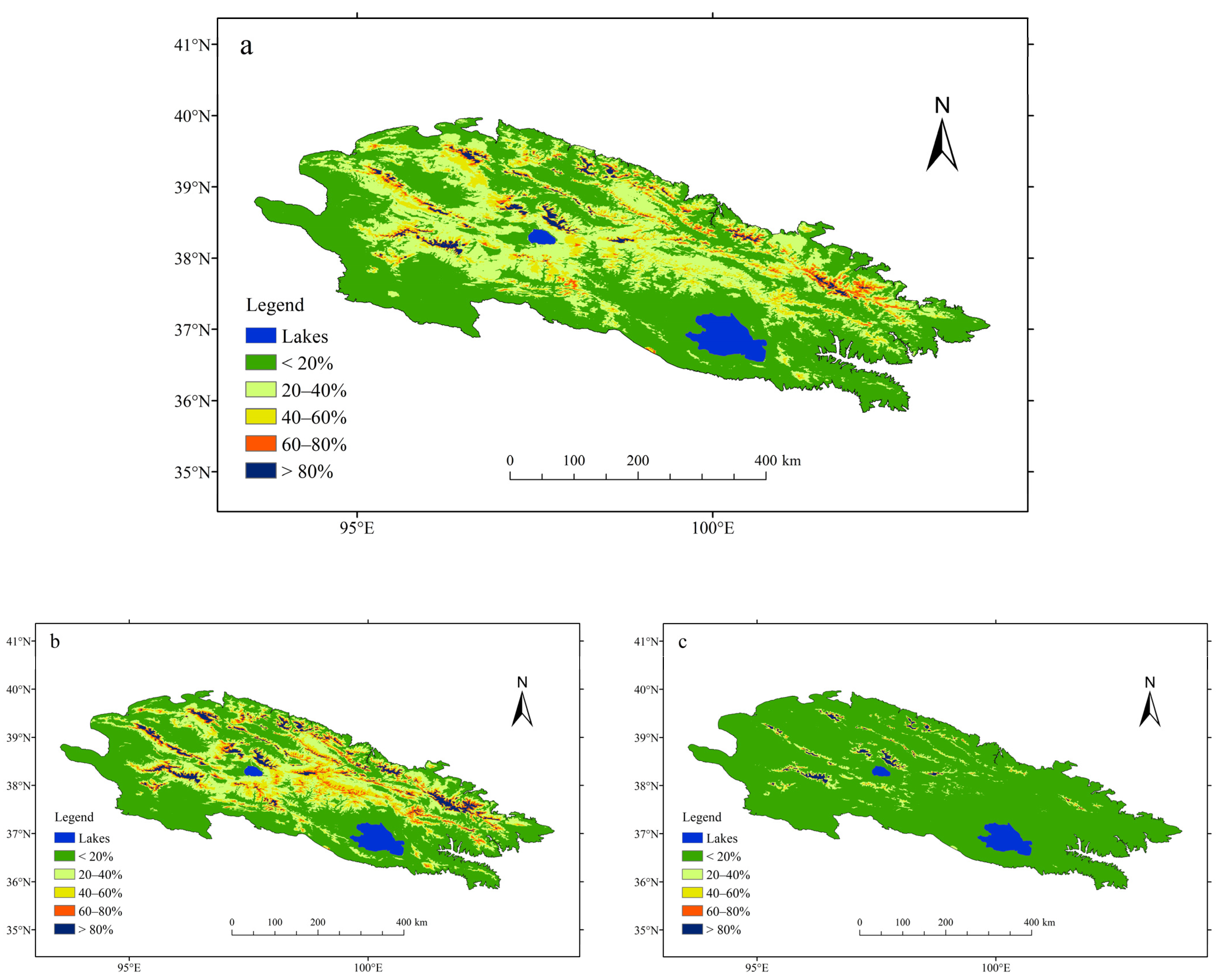


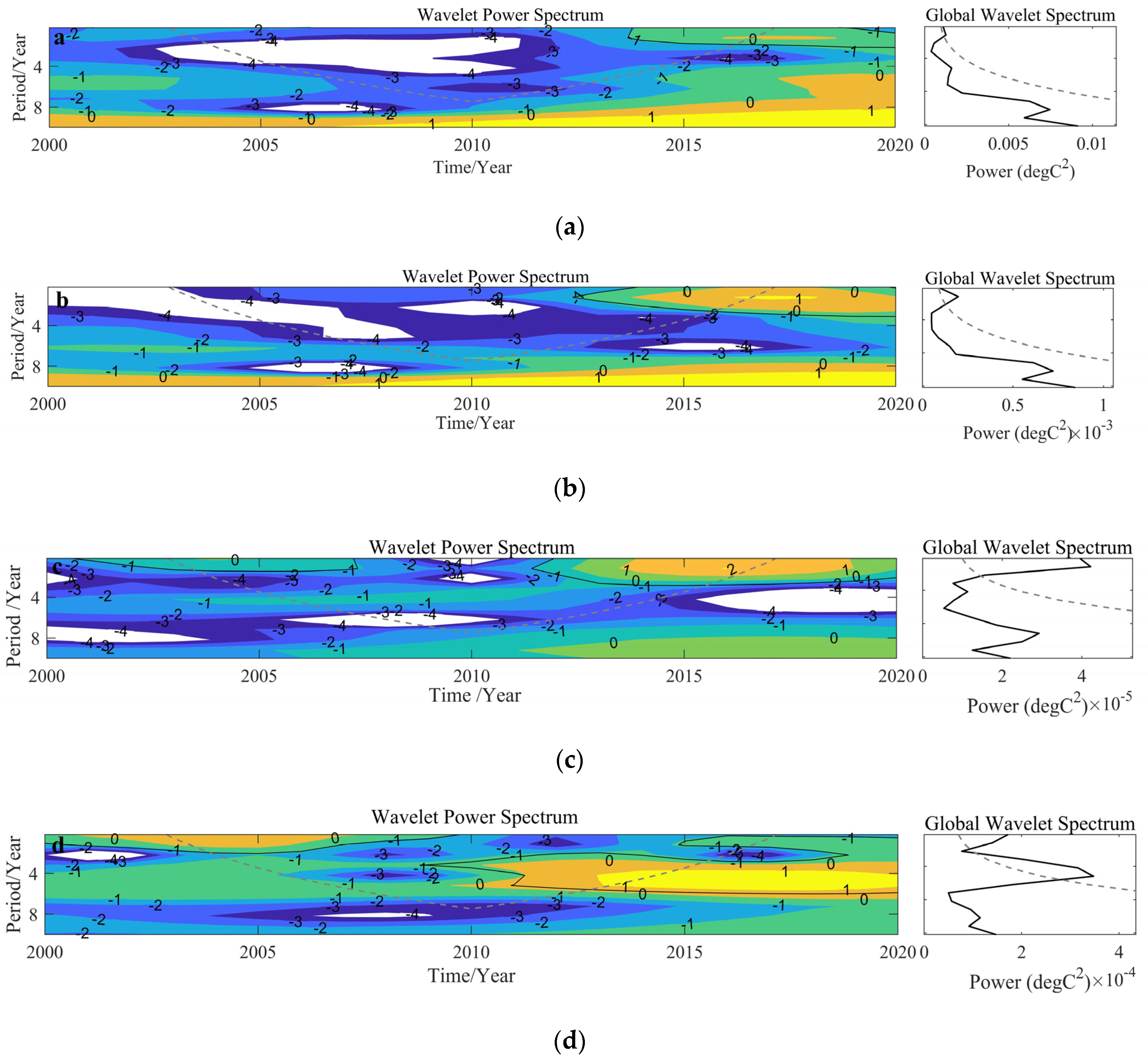



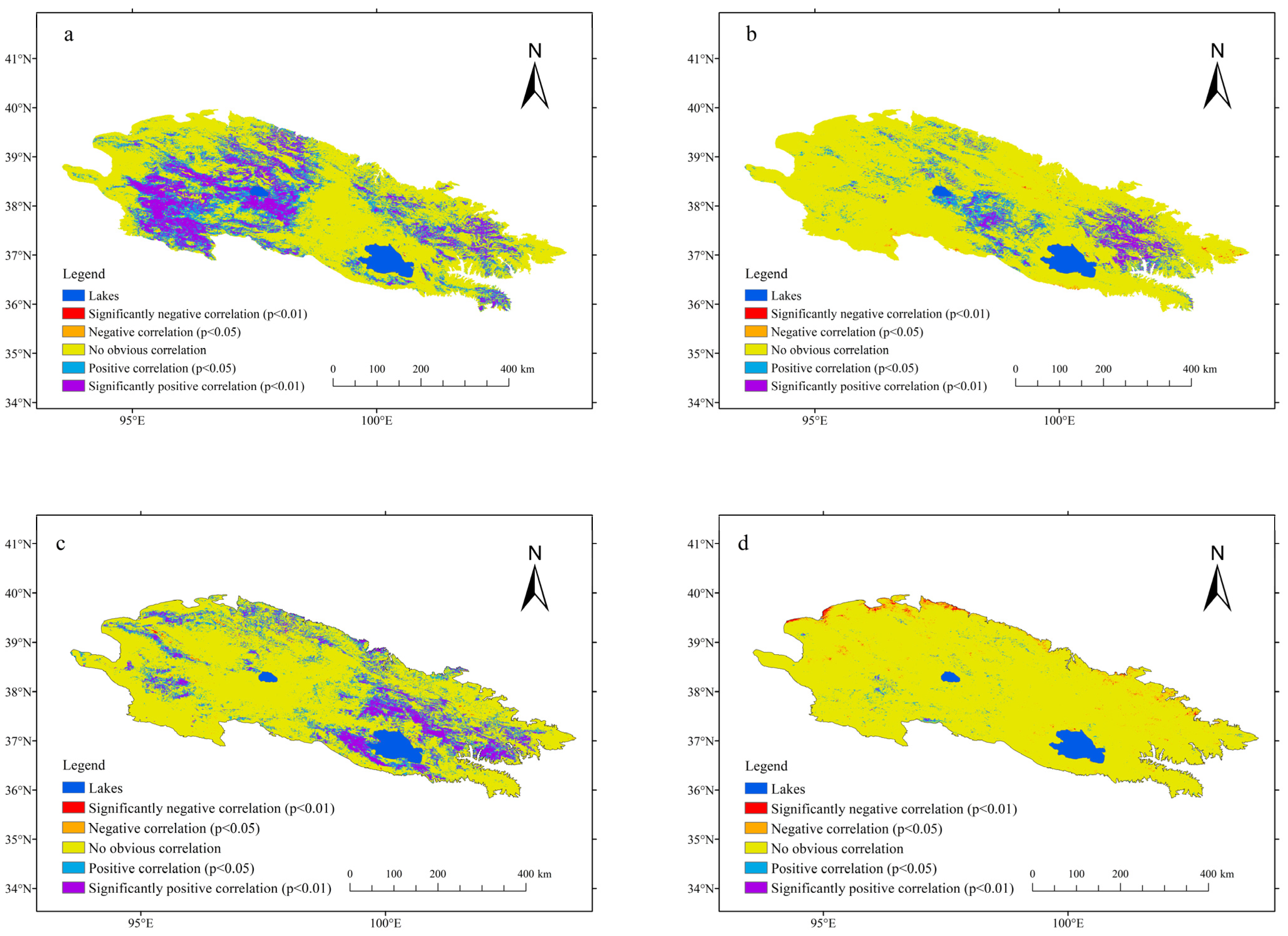

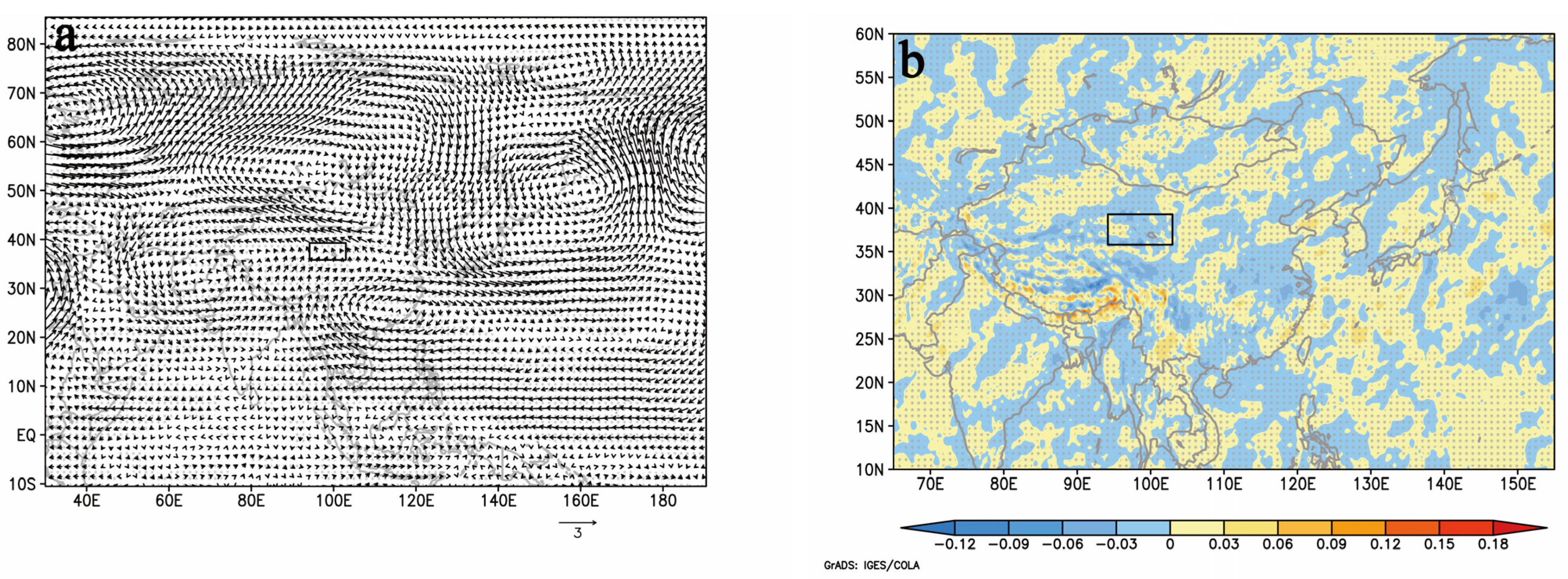
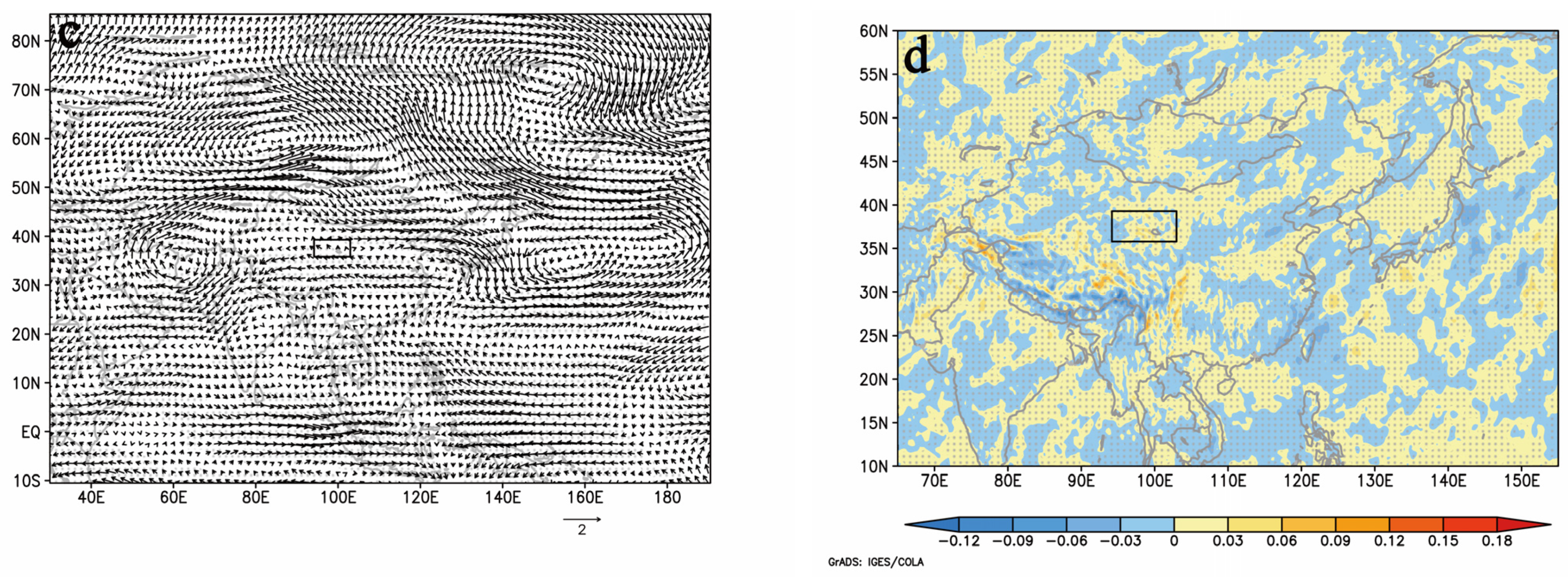
Publisher’s Note: MDPI stays neutral with regard to jurisdictional claims in published maps and institutional affiliations. |
© 2022 by the authors. Licensee MDPI, Basel, Switzerland. This article is an open access article distributed under the terms and conditions of the Creative Commons Attribution (CC BY) license (https://creativecommons.org/licenses/by/4.0/).
Share and Cite
Du, W.; Kang, S.; Qian, L.; Jiang, Y.; Sun, W.; Chen, J.; Xu, Z.; Sun, W.; Qin, X.; Chai, X. Spatiotemporal Variation of Snow Cover Frequency in the Qilian Mountains (Northwestern China) during 2000–2020 and Associated Circulation Mechanisms. Remote Sens. 2022, 14, 2823. https://doi.org/10.3390/rs14122823
Du W, Kang S, Qian L, Jiang Y, Sun W, Chen J, Xu Z, Sun W, Qin X, Chai X. Spatiotemporal Variation of Snow Cover Frequency in the Qilian Mountains (Northwestern China) during 2000–2020 and Associated Circulation Mechanisms. Remote Sensing. 2022; 14(12):2823. https://doi.org/10.3390/rs14122823
Chicago/Turabian StyleDu, Wentao, Shichang Kang, Libing Qian, Youyan Jiang, Wenxuan Sun, Jizu Chen, Zhilong Xu, Weijun Sun, Xiang Qin, and Xian Chai. 2022. "Spatiotemporal Variation of Snow Cover Frequency in the Qilian Mountains (Northwestern China) during 2000–2020 and Associated Circulation Mechanisms" Remote Sensing 14, no. 12: 2823. https://doi.org/10.3390/rs14122823
APA StyleDu, W., Kang, S., Qian, L., Jiang, Y., Sun, W., Chen, J., Xu, Z., Sun, W., Qin, X., & Chai, X. (2022). Spatiotemporal Variation of Snow Cover Frequency in the Qilian Mountains (Northwestern China) during 2000–2020 and Associated Circulation Mechanisms. Remote Sensing, 14(12), 2823. https://doi.org/10.3390/rs14122823






